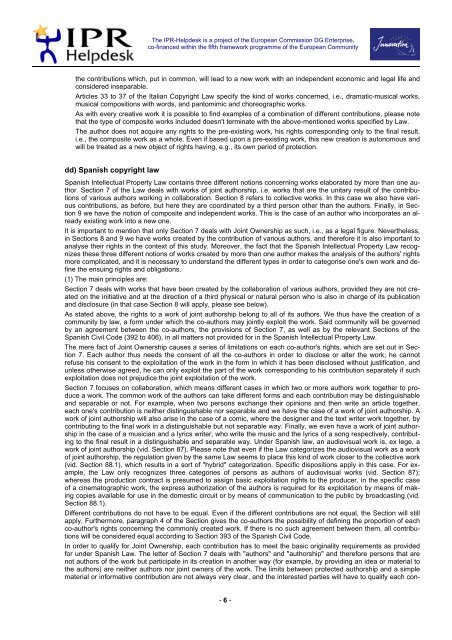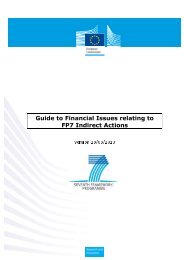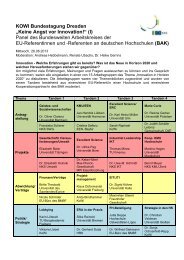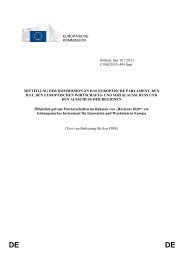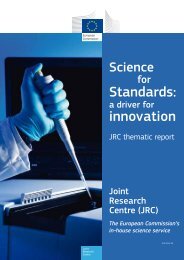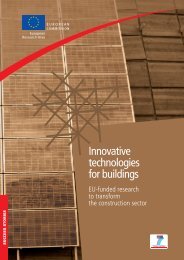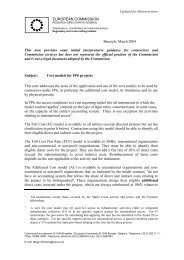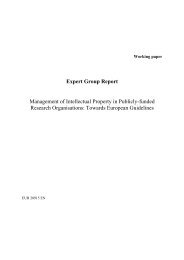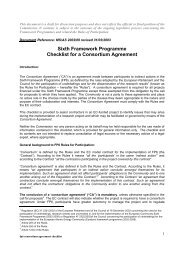Joint Ownership in Intellectual Property Rights - KoWi
Joint Ownership in Intellectual Property Rights - KoWi
Joint Ownership in Intellectual Property Rights - KoWi
Create successful ePaper yourself
Turn your PDF publications into a flip-book with our unique Google optimized e-Paper software.
The IPR-Helpdesk is a project of the European Commission DG Enterprise,<br />
co-f<strong>in</strong>anced with<strong>in</strong> the fifth framework programme of the European Community<br />
the contributions which, put <strong>in</strong> common, will lead to a new work with an <strong>in</strong>dependent economic and legal life and<br />
considered <strong>in</strong>separable.<br />
Articles 33 to 37 of the Italian Copyright Law specify the k<strong>in</strong>d of works concerned, i.e., dramatic-musical works,<br />
musical compositions with words, and pantomimic and choreographic works.<br />
As with every creative work it is possible to f<strong>in</strong>d examples of a comb<strong>in</strong>ation of different contributions, please note<br />
that the type of composite works <strong>in</strong>cluded doesn't term<strong>in</strong>ate with the above-mentioned works specified by Law.<br />
The author does not acquire any rights to the pre-exist<strong>in</strong>g work, his rights correspond<strong>in</strong>g only to the f<strong>in</strong>al result,<br />
i.e., the composite work as a whole. Even if based upon a pre-exist<strong>in</strong>g work, this new creation is autonomous and<br />
will be treated as a new object of rights hav<strong>in</strong>g, e.g., its own period of protection.<br />
dd) Spanish copyright law<br />
Spanish <strong>Intellectual</strong> <strong>Property</strong> Law conta<strong>in</strong>s three different notions concern<strong>in</strong>g works elaborated by more than one author.<br />
Section 7 of the Law deals with works of jo<strong>in</strong>t authorship, i.e. works that are the unitary result of the contributions<br />
of various authors work<strong>in</strong>g <strong>in</strong> collaboration. Section 8 refers to collective works. In this case we also have various<br />
contributions, as before, but here they are coord<strong>in</strong>ated by a third person other than the authors. F<strong>in</strong>ally, <strong>in</strong> Section<br />
9 we have the notion of composite and <strong>in</strong>dependent works. This is the case of an author who <strong>in</strong>corporates an already<br />
exist<strong>in</strong>g work <strong>in</strong>to a new one.<br />
It is important to mention that only Section 7 deals with <strong>Jo<strong>in</strong>t</strong> <strong>Ownership</strong> as such, i.e., as a legal figure. Nevertheless,<br />
<strong>in</strong> Sections 8 and 9 we have works created by the contribution of various authors, and therefore it is also important to<br />
analyse their rights <strong>in</strong> the context of this study. Moreover, the fact that the Spanish <strong>Intellectual</strong> <strong>Property</strong> Law recognizes<br />
these three different notions of works created by more than one author makes the analysis of the authors' rights<br />
more complicated, and it is necessary to understand the different types <strong>in</strong> order to categorise one's own work and def<strong>in</strong>e<br />
the ensu<strong>in</strong>g rights and obligations.<br />
(1) The ma<strong>in</strong> pr<strong>in</strong>ciples are:<br />
Section 7 deals with works that have been created by the collaboration of various authors, provided they are not created<br />
on the <strong>in</strong>itiative and at the direction of a third physical or natural person who is also <strong>in</strong> charge of its publication<br />
and disclosure (<strong>in</strong> that case Section 8 will apply, please see below).<br />
As stated above, the rights to a work of jo<strong>in</strong>t authorship belong to all of its authors. We thus have the creation of a<br />
community by law, a form under which the co-authors may jo<strong>in</strong>tly exploit the work. Said community will be governed<br />
by an agreement between the co-authors, the provisions of Section 7, as well as by the relevant Sections of the<br />
Spanish Civil Code (392 to 406), <strong>in</strong> all matters not provided for <strong>in</strong> the Spanish <strong>Intellectual</strong> <strong>Property</strong> Law.<br />
The mere fact of <strong>Jo<strong>in</strong>t</strong> <strong>Ownership</strong> causes a series of limitations on each co-author's rights, which are set out <strong>in</strong> Section<br />
7. Each author thus needs the consent of all the co-authors <strong>in</strong> order to disclose or alter the work; he cannot<br />
refuse his consent to the exploitation of the work <strong>in</strong> the form <strong>in</strong> which it has been disclosed without justification, and<br />
unless otherwise agreed, he can only exploit the part of the work correspond<strong>in</strong>g to his contribution separately if such<br />
exploitation does not prejudice the jo<strong>in</strong>t exploitation of the work.<br />
Section 7 focuses on collaboration, which means different cases <strong>in</strong> which two or more authors work together to produce<br />
a work. The common work of the authors can take different forms and each contribution may be dist<strong>in</strong>guishable<br />
and separable or not. For example, when two persons exchange their op<strong>in</strong>ions and then write an article together,<br />
each one's contribution is neither dist<strong>in</strong>guishable nor separable and we have the case of a work of jo<strong>in</strong>t authorship. A<br />
work of jo<strong>in</strong>t authorship will also arise <strong>in</strong> the case of a comic, where the designer and the text writer work together, by<br />
contribut<strong>in</strong>g to the f<strong>in</strong>al work <strong>in</strong> a dist<strong>in</strong>guishable but not separable way. F<strong>in</strong>ally, we even have a work of jo<strong>in</strong>t authorship<br />
<strong>in</strong> the case of a musician and a lyrics writer, who write the music and the lyrics of a song respectively, contribut<strong>in</strong>g<br />
to the f<strong>in</strong>al result <strong>in</strong> a dist<strong>in</strong>guishable and separable way. Under Spanish law, an audiovisual work is, ex lege, a<br />
work of jo<strong>in</strong>t authorship (vid. Section 87). Please note that even if the Law categorizes the audiovisual work as a work<br />
of jo<strong>in</strong>t authorship, the regulation given by the same Law seems to place this k<strong>in</strong>d of work closer to the collective work<br />
(vid. Section 88.1), which results <strong>in</strong> a sort of "hybrid" categorization. Specific dispositions apply <strong>in</strong> this case. For example,<br />
the Law only recognizes three categories of persons as authors of audiovisual works (vid. Section 87);<br />
whereas the production contract is presumed to assign basic exploitation rights to the producer, <strong>in</strong> the specific case<br />
of a c<strong>in</strong>ematographic work, the express authorization of the authors is required for its exploitation by means of mak<strong>in</strong>g<br />
copies available for use <strong>in</strong> the domestic circuit or by means of communication to the public by broadcast<strong>in</strong>g (vid.<br />
Section 88.1).<br />
Different contributions do not have to be equal. Even if the different contributions are not equal, the Section will still<br />
apply. Furthermore, paragraph 4 of the Section gives the co-authors the possibility of def<strong>in</strong><strong>in</strong>g the proportion of each<br />
co-author's rights concern<strong>in</strong>g the commonly created work. If there is no such agreement between them, all contributions<br />
will be considered equal accord<strong>in</strong>g to Section 393 of the Spanish Civil Code.<br />
In order to qualify for <strong>Jo<strong>in</strong>t</strong> <strong>Ownership</strong>, each contribution has to meet the basic orig<strong>in</strong>ality requirements as provided<br />
for under Spanish Law. The letter of Section 7 deals with "authors" and "authorship" and therefore persons that are<br />
not authors of the work but participate <strong>in</strong> its creation <strong>in</strong> another way (for example, by provid<strong>in</strong>g an idea or material to<br />
the authors) are neither authors nor jo<strong>in</strong>t owners of the work. The limits between protected authorship and a simple<br />
material or <strong>in</strong>formative contribution are not always very clear, and the <strong>in</strong>terested parties will have to qualify each con-<br />
- 6 -


